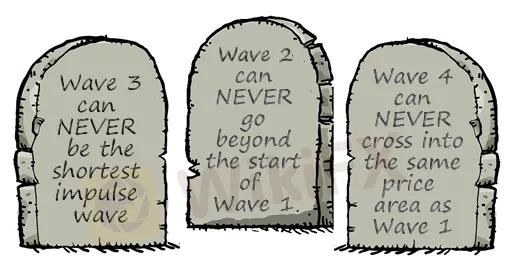简体中文
繁體中文
English
Pусский
日本語
ภาษาไทย
Tiếng Việt
Bahasa Indonesia
Español
हिन्दी
Filippiiniläinen
Français
Deutsch
Português
Türkçe
한국어
العربية
3 Cardinal Rules of Elliott Wave Theory
Abstract:When it comes to wave labeling, there are THREE cardinal "cannot-be-broken" laws. So, before you start using Elliott Wave Theory in your trading, you should familiarize yourself with the following guidelines. Failure to accurately categorize waves could lead to a devastating consequences on your balance.
As you may imagine, the ability to correctly identify waves is very important to employing Elliott Wave Theory in trading.
You'll be able to determine which side of the market to trade on, long or short, if you have the appropriate eye for detecting what wave the market is in.
When it comes to wave labeling, there are THREE cardinal “cannot-be-broken” laws.
So, before you start using Elliott Wave Theory in your trading, you should familiarize yourself with the following guidelines.
Failure to accurately categorize waves could lead to a devastating consequences on your balance.
Elliott Wave Theory's Three Cardinal Rules
Wave 3 can never be the shortest impulse wave, according to Rule #1.
Wave 2 can never reach beyond the beginning of Wave 1 (Rule #2).
Wave 4 can never cross a similar scale value like Wave 1 (Rule #3).
Trading Rules for Elliott Waves
Then there are recommendations to help you label waves correctly.
These principles, unlike the three cardinal rules, can be broken. They are as follows:
Wave 5 may or may not progress past the end of wave 3. This is called truncation.
Wave 5 often “breaks through” or “goes past” the trend line formed from Wave 3 and parallel to a trend line linking the beginnings of Waves 3 and 5.
Wave 3 is known for being very long, sharp, and stretched.
Fibonacci retracement levels are used by waves 2 and 4.

Disclaimer:
The views in this article only represent the author's personal views, and do not constitute investment advice on this platform. This platform does not guarantee the accuracy, completeness and timeliness of the information in the article, and will not be liable for any loss caused by the use of or reliance on the information in the article.
Read more

Forex is a game that I enjoy playing
These champions have one thing in common: they not only work their butts off, but they also enjoy what they do.

Wait patiently. Maintain your discipline
"Patience is the key to everything," American comic Arnold H. Glasgow once quipped. The chicken is gotten by hatching the egg rather than crushing it."

There isn't a Holy Grail to be found!
Ask any Wall Street quant (the highly nerdy math and physics PhDs who build complicated algorithmic trading techniques) why there isn't a "holy grail" indicator, approach, or system that generates revenues on a regular basis.

Concentrate on the Process. Profits aren't a priority
We've designed the School of WikiFX as simple and enjoyable as possible to help you learn and comprehend the fundamental tools and best practices used by forex traders all over the world, but keep in mind that a tool or strategy is only as good as the person who uses it.
WikiFX Broker
Currency Calculator






